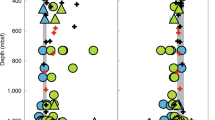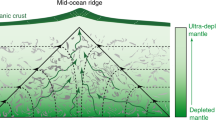Abstract
‘Recycled’ crustal materials, returned from the Earth's surface to the mantle by subduction, have long been invoked to explain compositional heterogeneity in the upper mantle1. Yet increasingly, problems have been noted with this model2,3. The debate can be definitively addressed using stable isotope ratios, which should only significantly vary in primitive, mantle-derived materials as a consequence of recycling. Here we present data showing a notable range in lithium isotope ratios in basalts from the East Pacific Rise, which correlate with traditional indices of mantle heterogeneity (for example, 143Nd/144Nd ratios). Such co-variations of stable and radiogenic isotopes in melts from a normal ridge segment provide critical evidence for the importance of recycled material in generating chemical heterogeneity in the upper mantle. Contrary to many models, however, the elevated lithium isotope ratios of the ‘enriched’ East Pacific Rise lavas imply that subducted ocean crust is not the agent of enrichment. Instead, we suggest that fluid-modified mantle, which is enriched during residency in a subduction zone, is mixed back into the upper mantle to cause compositional variability.
This is a preview of subscription content, access via your institution
Access options
Subscribe to this journal
Receive 51 print issues and online access
$199.00 per year
only $3.90 per issue
Buy this article
- Purchase on Springer Link
- Instant access to full article PDF
Prices may be subject to local taxes which are calculated during checkout


Similar content being viewed by others
References
Allègre, C. J. & Turcotte, D. L. Implications of a 2-component marble-cake mantle. Nature 323, 123–127 (1986)
Stracke, A., Bizimis, M. & Salters, V. J. M. Recycling oceanic crust: quantitative constraints. Geochem. Geophys. Geosyst. 4, 8003, doi:10.1029/2001GC000223 (2003)
Niu, Y. & O'Hara, M. J. Origin of ocean island basalts: a new perspective from petrology, geochemistry and mineral physics considerations. J. Geophys. Res. 108, 2209, doi:10.1029/2002JB002048 (2003)
Elliott, T., Jeffcoate, A. B. & Bouman, C. The terrestrial Li isotope cycle: light-weight constraints on mantle convection. Earth Planet. Sci. Lett. 220, 231–245 (2004)
Chan, L. H., Edmond, J. M., Thompson, G. & Gillis, K. Lithium isotopic composition of submarine basalts: implications for the lithium cycle in the oceans. Earth Planet. Sci. Lett. 108, 151–160 (1992)
Decitre, S. et al. Behavior of Li and its isotopes during serpentinization of oceanic peridotites. Geochem. Geophys. Geosyst. 3, 1007, doi:10.1029/2001GC000178 (2002)
Tomascak, P. B., Widom, E., Benton, L. D., Goldstein, S. L. & Ryan, J. G. The control of lithium budgets in island arcs. Earth Planet. Sci. Lett. 196, 227–238 (2002)
Brooker, R. A., James, R. H. & Blundy, J. D. Trace elements and Li isotope systematics in Zabargad peridotites: evidence of ancient subduction processes in the Red Sea mantle. Chem. Geol. 212, 179–204 (2004)
Zack, T., Tomascak, P. B., Rudnick, R. L., Dalpé, C. & McDonough, W. F. Extremely light Li in orogenic eclogites: the role of isotope fractionation during dehydration in subducted oceanic crust. Earth Planet. Sci. Lett. 208, 279–290 (2003)
Wunder, B., Meixner, A., Romer, R. L. & Heinrich, W. Temperature-dependent isotopic fractionation of lithium between clinopyroxene and high-pressure hydrous fluids. Contrib. Mineral. Petrol. 151, 112–120 (2006)
Niu, Y. L., Collerson, K. D., Batiza, R., Wendt, J. I. & Regelous, M. Origin of enriched-type mid-ocean ridge basalt at ridges far from mantle plumes: the East Pacific Rise at 11°20′N. J. Geophys. Res. 104, 7067–7087 (1999)
Regelous, M. et al. Variations in the geochemistry of magmatism on the East Pacific Rise at 10°30′N since 800 ka. Earth Planet. Sci. Lett. 168, 45–63 (1999)
Prinzhofer, A., Lewin, E. & Allègre, C. J. Stochastic melting of the marble cake mantle: evidence from local study of the East Pacific Rise at 12° 50′ N. Earth Planet. Sci. Lett. 92, 189–206 (1989)
Jeffcoate, A. B., Elliott, T., Thomas, A. & Bouman, C. Precise, small sample size determination of lithium isotopic compositions of geological reference materials and modern seawater by MC-ICP-MS. Geostand. Geoanal. Res. 28, 161–172 (2004)
Moriguti, T. & Nakamura, E. Across-arc variation of Li isotopes in lavas and implications for crust/mantle recycling at subduction zones. Earth Planet. Sci. Lett. 163, 167–174 (1998)
Tomascak, P. B. & Langmuir, C. H. Lithium isotope variability in MORB. Eos 80, F1086–F1087 (1999)
Seitz, H. M., Brey, G. P., Lahaye, Y., Durali, S. & Weyer, S. Lithium isotopic signatures of peridotite xenoliths and isotopic fractionation at high temperature between olivine and pyroxenes. Chem. Geol. 212, 163–177 (2004)
Jeffcoate, A. B. et al. Li isotope fractionation in peridotites and mafic melts. Geochim. Cosmochim. Acta (in the press)
Magna, T., Wiechert, U. & Halliday, A. N. New constraints on the lithium isotope compositions of the Moon and terrestrial planets. Earth Planet. Sci. Lett. 243, 336–353 (2006)
Chan, L. H., Alt, J. C. & Teagle, D. A. H. Lithium and lithium isotope profiles through the upper oceanic crust: a study of seawater-basalt exchange at ODP Sites 504B and 896A. Earth Planet. Sci. Lett. 201, 187–201 (2002)
Gillis, K. M. & Coogan, L. A. Anatectic migmatites from the roof of an ocean ridge magma chamber. J. Petrol. 43, 2075–2095 (2002)
Tomascak, P. B., Tera, F., Helz, R. T. & Walker, R. J. The absence of lithium isotope fractionation during basalt differentiation: new measurements by multicollector sector ICP-MS. Geochim. Cosmochim. Acta 63, 907–910 (1999)
Lundstrom, C. C., Chaussidon, M., Hsui, A. T., Kelemen, P. & Zimmerman, M. Observations of Li isotopic variations in the Trinity Ophiolite: evidence for isotopic fractionation by diffusion during mantle melting. Geochim. Cosmochim. Acta 69, 735–751 (2005)
Zindler, A., Staudigel, H. & Batiza, R. Isotope and trace element geochemistry of young Pacific seamounts: implications for the scale of upper mantle heterogeneity. Earth Planet. Sci. Lett. 70, 175–195 (1984)
Donnelly, K. E., Goldstein, S. L., Langmuir, C. H. & Spiegelman, M. The origin of enriched ocean ridge basalts and implications for mantle dynamics. Earth Planet. Sci. Lett. 226, 347–366 (2004)
Cooper, K. M., Eiler, J. M., Asimow, P. D. & Langmuir, C. H. Oxygen isotope evidence for the origin of enriched mantle beneath the mid-Atlantic ridge. Earth Planet. Sci. Lett. 220, 297–316 (2004)
Eiler, J. M., Schiano, P., Kitchen, N. & Stolper, E. M. Oxygen-isotope evidence for recycled crust in the sources of mid-ocean-ridge basalts. Nature 403, 530–534 (2000)
Hirose, K., Takafuji, N., Sata, N. & Ohishi, Y. Phase transition and density of subducted MORB crust in the lower mantle. Earth Planet. Sci. Lett. 237, 239–251 (2005)
Sun, S.-S. & McDonough, W. F. in Magmatism in the Ocean Basins (eds Saunders, A. D. & Norry, M. J.) 313–345 (Blackwell, London, 1989)
Brueckner, H. K., Zindler, A., Seyler, M. & Bonatti, E. Zabargad and the isotopic evolution of the sub-Red Sea mantle and crust. Tectonophysics 150, 163–176 (1988)
Acknowledgements
Analytical work was supported by a Philip Leverhulme Prize awarded to T.E. A.J. was supported by an NERC studentship. Reviews by B. Leeman were appreciated. We also thank J. Blundy, C. Hawkesworth and D. Vance for comments on versions of the mansucript.
Author information
Authors and Affiliations
Corresponding author
Ethics declarations
Competing interests
Reprints and permissions information is available at www.nature.com/reprints. The authors declare no competing financial interests.
Supplementary information
Supplementary Table 1
Table of all EPR MORB Li isotope data (DOC 40 kb)
Rights and permissions
About this article
Cite this article
Elliott, T., Thomas, A., Jeffcoate, A. et al. Lithium isotope evidence for subduction-enriched mantle in the source of mid-ocean-ridge basalts. Nature 443, 565–568 (2006). https://doi.org/10.1038/nature05144
Received:
Accepted:
Issue Date:
DOI: https://doi.org/10.1038/nature05144
This article is cited by
-
Earth’s mantle composition revealed by mantle plumes
Nature Reviews Earth & Environment (2023)
-
Addition of H2O at the Baishiquan and Tianyu magmatic Ni-Cu sulfide deposits, southern Central Asian Orogenic Belt, China: evidence from isotopic geochemistry of olivine and zircon
Mineralium Deposita (2022)
-
Cl, Br, B, Li, and noble gases isotopes to study the origin and evolution of deep groundwater in sedimentary basins: a review
Environmental Chemistry Letters (2022)
-
Competing effects of spreading rate, crystal fractionation and source variability on Fe isotope systematics in mid-ocean ridge lavas
Scientific Reports (2021)
-
Petrogenesis of the Ultramafic Zone of the Stillwater Complex in North America: constraints from mineral chemistry and stable isotopes of Li and O
Contributions to Mineralogy and Petrology (2020)
Comments
By submitting a comment you agree to abide by our Terms and Community Guidelines. If you find something abusive or that does not comply with our terms or guidelines please flag it as inappropriate.



